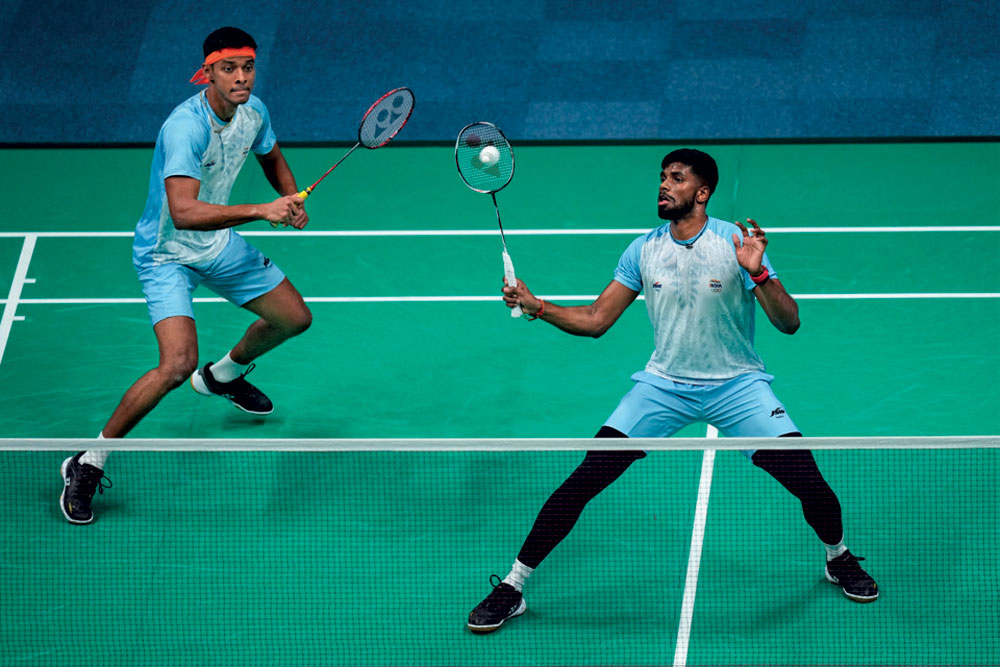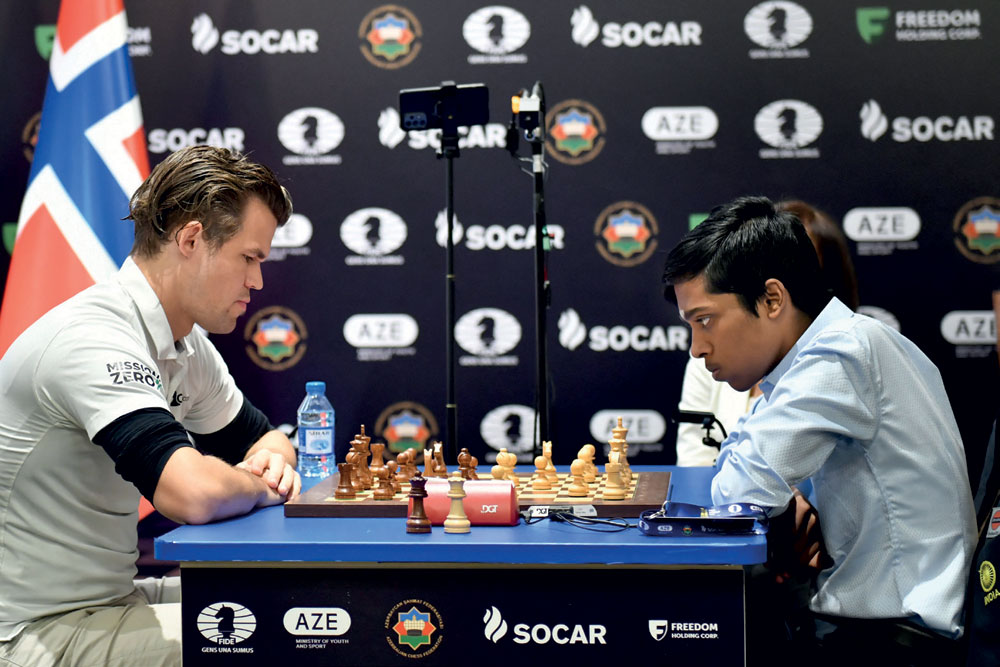Grit and Glory
The cricket World Cup may have ended in heartbreak, but India scaled new peaks at the Asian Games
 Lhendup G Bhutia
Lhendup G Bhutia
 Lhendup G Bhutia
Lhendup G Bhutia
 |
15 Dec, 2023
|
15 Dec, 2023
/wp-content/uploads/2023/12/Sports1.jpg)
The Indian delegation at the opening ceremony of the 19th Asian Games in Hangzhou, China, September 23, 2023 (Photos: Getty Images)
TWO YEARS AGO, A LITTLE-KNOWN JAVELIN thrower from Odisha breached the 75 metre-mark for the first time in his life. Kishore Jena, a former volleyball player, like most track and field athletes in India, had turned to sport to land a job. He had until then mostly been registering throws in the early 70s. The 75m-mark was good enough to get him noticed, but, as Neeraj Chopra has shown us, not outstanding enough to bring laurels. Next year, he threw 76m and made it to the national camp.
At this year’s Asian Games, on a night filled with controversy and intrigue—Neeraj Chopra’s first throw seemed to have crossed 86m, but was not measured; Jena’s second was disqualified before it was overturned on appeal—Jena ran in for his third throw and flung the spear 86.77m away. He had never thrown a javelin this far, and he was suddenly in the lead of a line-up that included India’s greatest track and field star of all time. Jena looked ecstatic, but also sheepish, even as Chopra cheered him on. In the stands, the Indian contingent was breaking out in joy at this unexpected result.
But then Chopra, who had been underwhelming by his standards that night, came and did what he does under pressure. He threw a monstrous 88.88m with his fourth and sealed his gold, even though Jena would throw 87.54m right after, resulting in one of those rare sporting moments in Indian history—a one-two finish.
Chopra did what is by now expected of him. But what about Jena? How does one go from 75m to 87.54m in two years? That too, to register two personal bests on perhaps the biggest night of his life. “People say it is a miracle,” Samarjeet Singh Malhi, Jena’s coach, would later tell reporters when they reached him in Patiala. “But in sports, there are no miracles. This is the result of Jena’s unwavering dedication and commitment to get better.”

Dedication and commitment. It is a phrase one can expand to explain, not just the journey of a javelin from 75m to 87.54m, but also that of 2018 Jakarta’s 70 medals to 2023 Hangzhou’s 107 medals for India, and perhaps even much of the sporting glory that came this year. Whether it was Chopra and Jena; or the others who registered India’s best-ever show at the Asian Games at Hangzhou (with 107 medals, including 35 golds); or the badminton pair of Satwiksairaj Rankireddy and Chirag Shetty pretty much everywhere this year; or chess prodigies like Praggnanandhaa; or even the Indian male cricket team who dominated the World Cup like few teams ever have in the tournament’s history, although it ended in a heartbreak; the country’s athletes, with dedication and commitment, oodles of pluck and self-belief, and with the help of a supportive administration, made 2023 one of the more enriching years in sport for the country.
Indian athletes, with dedication and commitment, oodles of pluck and self-belief, and with the help of a supportive administration, made 2023 one of the more enriching years in sport for the country
Indians love to forecast. When the Indian contingent was leaving for Hangzhou, the conversation had already moved to a prediction of 100 medals. India has been growing as a sporting nation, as evidenced by its showing in the last Olympics and last year’s Commonwealth Games. But 100 medals? Really? For that to happen, India would have to reap rich harvests in fields it normally does well in like shooting, hockey, wrestling, and kabaddi, but also secure many more in other fields. As it turned out, the country would win in 22 sporting disciplines compared to 2018’s 18. The biggest contributions this time came from athletics (where it went from 20 in 2018 to 29) and shooting (where it went from nine to 22). There were of course some disappointments. The haul of just one silver and five bronze medals in wrestling, with none for the Olympic medallist Bajrang Punia, mirroring perhaps the turmoil the discipline witnessed outside the arena, and just five medals in boxing, without a single gold, not even from Nikhat Zareen and Lovlina Borgohain, felt like let-downs.

But the positives outweighed these. In badminton, the pair of Sat-Chi (Satwiksairaj Rankireddy and Chirag Shetty) took the country to unprecedented highs. They won several big titles this year, including the country’s first-ever Super 1000 trophy and a World No 1 ranking as well. But it was their gold at the Asian Games, a first-ever in badminton for India, in a draw that had the Olympic champions, the reigning and former world champions as well as China and Indonesia’s top pairs, which brought Sat-Chi their greatest satisfaction. Badminton would bring more riches, including a silver for the men’s team, and a bronze courtesy HS Prannoy in men’s singles. The other racquet sport where India registered its presence, table tennis, might have brought just one bronze. But by defeating strong Chinese players, the bronze by the pair of Sutirtha Mukherjee and Ayhika Mukherjee, was in reality among the most significant. Defending its strongholds in hockey and kabaddi felt well, but it was really medals in badminton and table tennis, which are dominated by other Asian countries, that pointed towards real sporting progress. Comparing the medal tally with table toppers China, with their 383 medals, including 201 golds, might feel humbling, but by crossing the three-digit tally and joining the regular members China, Japan and South Korea, India didn’t just clear a big psychological hurdle, but also announced itself as a country to be taken more seriously in the sporting arena.

The achievements of India’s athletes went beyond the Asian Games. India’s star javelin thrower Chopra made his presence felt beyond Hangzhou. Although the 90m-mark continued to elude him, and he also suffered a brief injury setback mid-way into the season, he continued to extend his dominance in the sport. He won gold at the World Athletics Championships in Budapest, a first for an Indian athlete. This also means that he has won every major title possible in his sport, from his Olympic and World Athletics Championships golds, the Diamond League title last year, and golds at the Asian Athletics Championships, Asian Games, and Commonwealth Games. This gold at the World Championships was followed by a second place at this year’s Diamond League, and the Asian Games gold. But Chopra’s triumphs weren’t the only positive for Indian javelin sport. Just two years after Chopra’s historic achievement at Tokyo, newfound confidence in this discipline seems to be growing, as two more world-class javelin throwers, Kishore Jena and DP Manu, emerged almost out of nowhere.

In chess, a new and exciting era appeared to have dawned. India’s growing strength has been apparent for some time but this was the year when some big moments occurred. In September, D Gukesh, a 17-year-old with a scraggly beard, became the first Indian to surpass the Indian chess legend Viswanathan Anand in FIDE’s published world rankings. A week before the rankings were published, India’s other chess prodigy, the 18-year-old R Praggnanandhaa, was sitting opposite Magnus Carlsen, arguably the greatest chess player of all time, for the Chess World Cup final.
When the Indian contingent was leaving for Hangzhou, the conversation had already moved to a prediction of 100 medals. India has been growing as a sporting nation, as evidenced by its showing in the last Olympics and last year’s Commonwealth Games. As it turned out, the country would win in 22 sporting disciplines compared to 2018’s 18
Praggnanandhaa, who was seeded 31 in the world, was nowhere close to being considered a favourite to reach the final when the tournament started. But something changed during the World Cup. In a tournament when he went from being a kid to an adult (Praggnanandhaa turned 18 during the World Cup), he sent some of the game’s biggest names, from Hikaru Nakamura to Fabiano Caruana, packing. He eventually lost the final against Carlsen, but for those three days of the final, he turned a country of passionate cricket devotees into fans of the 64-square game. But it wasn’t just Gukesh or Praggnanandhaa. India currently appears to be in the midst of a chess revolution, as many young chess grandmasters appear. According to FIDE’s recently published December ratings list, there are 10 men, and another 10 women, in the top 100 male and female categories. Many of them, like Gukesh and Praggnanandhaa, are still in their teens, which means their peak is yet to come. There is little wonder thus that when the Russian chess great Vladimir Kramnik was asked by a Russian portal about the likely success of the upcoming generation of Russian chess players earlier this year, he turned instead to the crop of Indian chess players emerging. “There are prospects. But now we’re a bit unlucky because an outstanding Indian generation has emerged… these are just outstanding, unique talents, four or five people at once in one generation. Even in the Soviet Union, this was extremely rare,” he said.

The biggest heartbreak in Indian sport was to come in the game where the most adoration is poured. The Indian cricket team dominated the World Cup campaign in a way no team has ever done in the history of the tournament. Virat Kohli emerged as the tournament’s most prolific run scorer and Mohammad Shami, its leading wicket-taker. But more than individual achievements, it was the way the team cohesively came together, finding answers to whatever questions that came their way, whether it was dealing with an injury to their only medium pacer-allrounder or junking their old model of risk-free cricket to a faster-paced approach. The loss in the final would have stung, but there was no dishonour in it. Australia weren’t the best team in the tournament, but like they have been doing for a long time, they brought their best to a match that mattered the most. It shouldn’t have surprised the Indian team. Something similar happened even earlier this year, when India made their way to their second World Test Championship final in a row, only to lose to the Australians.

To many, the lasting visuals of India’s year in sport might be the glum faces of the Indian team as the final drew to a close. But there are many other contenders for this moment too. Like the Sat-Chi celebrations at the end of their wins. Or Jyothi Yarraji, who was unfairly disqualified during the 100m hurdle at Hangzhou for a false start, standing her ground in her debut Asian Games, her hands on her hips, to be eventually allowed to run and win a silver. It could also easily be the duo of Chopra and Jena, the former helping and cheering the newbie from Odisha, even standing up for Jena when he was wrongly fouled, while also competing with him for the gold.

/wp-content/uploads/2025/07/Cover-Shubman-Gill-1.jpg)












More Columns
‘Fuel to Air India plane was cut off before crash’ Open
Shubhanshu Shukla Return Date Set For July 14 Open
Rhythm Streets Aditya Mani Jha